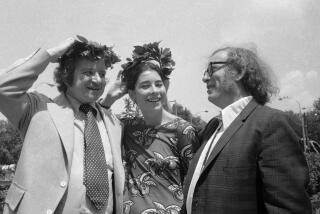NOTES FROM THE JUNGLE’S EDGE The Journalism of Barry Farrell <i> edited by Steve Hawk introduction by John Gregory Dunne (Creative Arts Book Co.: $16.95; 240 pp.) </i>
- Share via
Barry Farrell’s writing falls in the general category of “as I experienced it” journalism, the neurotic, participatory journalism focusing on the ego of the writer--what used to be called “The New Journalism.” In many cases, the style is repellently egomaniacal, spotlighting the writer rather than the subject. Farrell, however, uses the style beautifully; his pieces are an invitation, and his experience opens a door to the subject at hand.
In Farrell’s hands, a cliche subject such as teaching poetry to children comes across as a revelation. He is attracted to the child-poets because of the charm of their naive images, but then, he writes, “I began to perceive that my parental pleasure in these verses was tinged with professional envy.” Through the admiration he feels for the poetry, the reader glimpses the children’s triumph.
The poetry piece is an atypical subject in the Farrell collection. Farrell’s fascination with the dark side of life is evidenced in long pieces on crime such as “The Court Said the Victims Invited the Trouble” and “Stalking the Hillside Strangler” (Farrell, who died in 1984, spent his last years in Los Angeles). No matter how sensational or newsy the topic, however, his articles are always “think pieces” that manage to comment on human issues. “How I Got to Be This Hip” reports Farrell’s conversation with a pimp, but underneath, it explores people’s propensity for self-glorification. In a relatively short article on the explosion of sex papers on the newsstands, he deals with questions of art, fear, love, eroticism and the effect of censorship on people’s tastes.
Farrell cast a critical eye on his time. In a 1969 piece assessing the Woodstock festival, he wrote of the “counter-miracle” worked by the great cultural landmark, which transformed “the freedom to get stoned” into “a force that kept tens of thousands content to sit in the mud and feed on a merchandised version of the culture they created.” Although many people would make similar observations later, Farrell wrote at the time of the concert: “The Rubicon we felt ourselves crossing was the line of restraint between the old drug culture of the underground and some new authorized form, dangerously adaptable to the interests of packagers, promoters, the controllers of crowds.” What a pity Farrell is no longer around to take aim at some of today’s targets.
More to Read
Sign up for our Book Club newsletter
Get the latest news, events and more from the Los Angeles Times Book Club, and help us get L.A. reading and talking.
You may occasionally receive promotional content from the Los Angeles Times.






